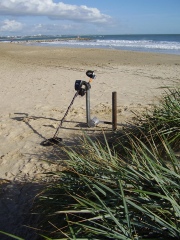
There be gold in them thar wet sands!
What I’ve been saying for years about one aspect of beachcombing with a metal detector has morphed into something of a ‘soapbox’ of mine. Many devotees of our great leisure pursuit, including a few who ought to know better, still cling to that load of old cojones that salt, when wet, affects the performance of a metal detector. IT DOES NOT. IT NEVER HAS. IT NEVER WILL! Comprende? Great, because it’s not up for negotiation
Equally, a few hoary old clichés still sway in the metal detecting breeze; of which, “salt-wet sand” (actually, seawater-soaked sand) is a meaningless term. The fact that it comes from the mouths of ‘Field Testers’ only compounds the felony.
I watched an excellent beachcombing video recently featuring an expert detectorist – who shall remain nameless – whose proficiency and knowledge is beyond reproach and one whom I greatly admire. All was going well until – oh, dearie me – he trotted out a classic piece of detecting scatology; that it’s necessary on the seawater sodden part of the beach to Ground Balance the metal detector so as to tune out the salt! “The detector sees the salt as a signal,” he advised. No, no, no! My head was in my hands. I’m sure, in my heart-of-hearts, his words were a slip of the tongue and what he really meant to say was saltwater, but I’m afraid many will take his advice as Gospel.
Try this. Take a large bag of salt and wet it thoroughly, then pass your metal detector over it. I’ll leave you to discover the result.
California’s Stanford University, reportedly carried out research on the composition of seawater and found that it contains forty-seven minerals and metals held in dilute suspension. I’ll list them (but try and stay awake by the end): –
1. Chloride 18,980 parts per million (ppm)
2. Sodium (10,561 ppm)
3. Magnesium (1,272 ppm)
4. Sulphur (884 ppm)
5. Calcium (400 ppm)
6. Potassium (380 ppm)
7. Bromine (65 ppm)
8. Inorganic carbon (28 ppm)
9. Strontium (13 ppm)
10. Boron (4.6 ppm)
11. Silicon (4 ppm)
12. Organic carbon (3 ppm)
13. Aluminium (1.9 ppm)
14. Fluorine (1.4 ppm)
15. Nitrogen in the form of nitrate (0.7 ppm)
16. Organic nitrogen (0.2 ppm)
17. Rubidium (0.2 ppm)
18. Lithium (0.1 ppm)
19. Phosphorous in the form of phosphate (0.1 ppm)
20. Copper (0.09 ppm)
21. Barium (0.05 ppm)
22. Iodine (also 0.05 ppm)
23. Nitrogen in the form of nitrite (also 0.05 ppm)
24. Nitrogen in the form of ammonia (once more 0.05 ppm)
25. Arsenic (0.024 ppm)
26. Iron (0.02 ppm)
27. Organic phosphorous (0.016 ppm)
28. Zinc (0.014 ppm)
29. Manganese (0.01 ppm)
30. Lead (0.005 ppm)
31. Selenium (0.004 ppm)
32. Tin (0.003 ppm)
33. Caesium (0.002 ppm)
34. Molybdenum (also 0.002 ppm)
35. Uranium (0.0016 ppm).
36. Gallium (0.0005 ppm)
37. Nickel (also 0.0005 ppm)
38. Thorium (also 0.0005 ppm)
39. Cerium (0.0004 ppm)
40. Vanadium (0.0003 ppm)
41. Lanthanum (also 0.0003 ppm)
42. Yttrium (also 0.0003 ppm)
43. Mercury (once more 0.0003 ppm)
44. Silver (also 0.0003 ppm)
45. Bismuth (0.0002 ppm)
46. Cobalt (0.0001 ppm)
47. Gold (0.000008 ppm)
Still awake? Great. So, the next time you encounter seawater-soaked sand or are out on the foreshore, it’s all those pesky 47 metals you’ve got to Ground Balance out – NOT THE SALT. “Yeah,” I hear someone whimper, “but my machine don’t have no ground balance.” Then, reduce the SENSITIVITY. Simples!
Actually it’s anything but simples! It’s easier to get a camel through the eye of a needle than it is to persuade a Tekkie to lower the SENSITIVTY control. Too much SENS seriously unbalances the machine’s responses making it difficult to pick out the good signals from the spurious noises – all coming through the headphones simultaneously.
Imagine driving a car in dense fog. If you bring to headlights up to Full Beam you’ll get a serous amount of reflection back from the fog, BUT, if you ‘Dip’ the headlight beam you’ll see much further ahead. And so it is with the SENS control on a metal detector.
Embrace the SENS control. It’s your best friend.
There’s a fortune out there waiting be found, and judicious use of the SENS control will help you get it!
………………………………………………..

Great post-You are dead on with that! It’s really common sense if you think about it.
LikeLike
Yep!
LikeLike
You left out three minerals!!
LikeLike
Jeez! Really? And they are? Or, are you being Barfordian?
LikeLike
All true! Good post John!
LikeLike